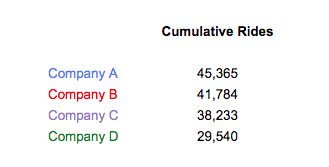
To keep growing private investment in micromobility, operators need assurance from cities that they will be able to keep permits on a long term basis. Set term pilots have been a great way for cities to introduce micromobility, but for companies to be able to invest properly in vehicles, safety, and their local teams, an ongoing framework is needed that lets companies continue if they are successful.
So — what makes micromobility successful in a city?
RIDES.
Fleet operators like rides for revenue; city governments like rides for showing multimodal strength; and residents, even those who hate dockless scooters or bikes, can look at a rider and see one less person creating car traffic or taking a parking spot.
And more rides solve a variety of problems typically associated with micromobility such as:
The regulatory framework below is designed to create an “operator score” that has a singular focus around rides. There are rules, of course, which are outlined below, but breaking the rules result in temporary fleet size reductions, which hinder a company’s ability to get rides.

It should all boil down to this
The hope is that a quantifiable approach can be adopted across cities so that there can be a standardized way of looking at a company’s on-the-ground success. There is a lot of fluff in micromobility with PR, events, and promotions, but all that is just noise if it doesn’t translate to more rides. As more cities are evaluating future pilots, they can look to cities that use this score as a transparent way to understand who the best operators are. This approach will help keep the playing field level for local and smaller providers who place a lot of effort on making sure their vehicles are safely used.
1) Simplicity: there are 4 areas of regulatory adherence, with straightforward metrics in each one: